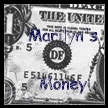
I used to make homemade yogurt fairly often, but for some reason got away from the habit. I knew I'd probably want to make it again, so I kept the yogurt maker I picked up at a thrift store several years ago. It once had little white glass jars with snap-on plastic lids, but after losing one of the lids, I found out that a jelly-sized canning jar fits just right. I've used the jars ever since. Since you don't need the jars to seal, you don't necessarily have to use new flats or rings. Clean used ones work just fine.
Homemade yogurt, in my experience, is thinner than the store bought version (which sometimes has gelatin or food starch added as stabilizers). I generally don't mind the thinner texture, but sometimes, when adding flavorings, it becomes even thinner. If you find your yogurt too thin to eat, don't toss it out. Use it in smoothies, pancake batters, cake recipes, etc., for added flavor and moisture.
There is savings to be had by making your own yogurt. It works out to roughly half the price of commercially prepared yogurt. It's also preservative free, and for me, just something fun to do in the kitchen.
Here's my basic recipe for plain yogurt. I don't remember where I found it and I don't know if the addition of dry milk is to add body, but it does add calcium.
Homemade Yogurt
1 quart 2% milk
1/3 cup dry instant milk powder
1 heaping Tablespoon commercially prepared PLAIN yogurt
Combine liquid and dry milk. Mix well, scald by bringing just to a simmer over medium heat, being careful not to scorch the milk.
Let cool to between 110°F and 120°F. (My yogurt maker has a nifty measuring spoon with a built-in thermometer.)
Whisk in the yogurt, making sure it's well-combined with the milk.
Divide evenly between 5 jelly jars.
Close jars with flats and rings. Place in yogurt maker and let process for 7 to 10 hours. In my experience, a shorter processing time yields sweeter, but looser, yogurt. A longer processing time yields a firmer texture, but the yogurt may be more tart than you'd like.Once processed to your liking, remove jars from yogurt maker and refrigerate until needed.
Flavoring Yogurt
This recipe is for plain, unsweetened yogurt. I use it plain in smoothies and as substitute for sour cream on potatoes and in dips.
There are lots of ways to flavor your homemade yogurt. The easiest is to simply spoon it over fresh, canned or frozen fruit.
Some other ways I've flavored it include:
- Mixing 1/3 cup (a 4-serving pkg.) of any flavor of Jell-O with 1 cup boiling water until dissolved completely, then adding 6-8 ounces of plain yogurt. Blend well with handheld blender or whisk and pour into 2 clean jars. This will set up to a firm consistency.
- Adding 1/2 teaspoon vanilla extract and 1 Tablespoon sugar to 6-8 ounces plain yogurt.
- Adding 2-3 teaspoons of sweetened drink mix (any flavor) to 6-8 ounces plain yogurt.
- Adding 1 teaspoon almond extract, 1 teaspoon sugar, 2 canned apricot halves (diced) and a spoonful or two of the syrup from the canned apricots to 6-8 ounces plain yogurt.
- Stirring 1 tablespoon Jell-O, any flavor, into 6-8 ounces plain yogurt. Eat immediately.
- Adding 1/2 a package of dry ranch dressing mix or Italian dressing mix into 6-8 ounces plain yogurt. Use as a dip or potato topper.
- Make a smoothie or shake by blending 6-8 ounces plain yogurt, 1 cup milk, and 1 cup of any combination of fresh, canned or frozen fruit. Add a bit of vanilla extract and sugar as desired.






















7 comments:
When we lived in Indonesia, we couldn't get yogurt. So, every time I left the country, I came back with ONE container of live-culture yogurt in a plastic bag in my carry-on tote. I also had one of those small "blue ice" thingies in the plastic bag, to keep the yogurt cool all the way across the Pacific.
From one live-culture starter, I could make yogurt for about 4 months.
Didn't have one of those nifty yogurt makers, though. I just sat the covered container of yogurt on...an ordinary heating pad, set at "Low."
Gay: I think I may have tried that once a long time ago. Either that or by placing the jars in a crockpot on low. That was years ago, though.
I've tried to culture yogurt from my homemade stuff, but it doesn't seem to work for me. Is that what you did to make it last 4 months?
The secret is buying a LIVE CULTURE yogurt..usually available at health food stores.
Thanks for the tip, Gay. I need to to the health food store soon for a few bulk spices, so I'll look for the yogurt there.
I made yogurt in the Crock Pot for the first time using Tillamook Yogurt with live cultures from the regular grocery store as my starter. It worked beautifully! Tillamook is an Oregon company that we can get in California, and it's our favorite store-bought yogurt. Mine came out runnier, of course (they add Kosher gelatin and cornstarch), but somehow subtler in flavor and creamier.
Has anyone tried adding dried milk powder to thicken their yogurt?
We're living in Japan. Yoghurt is a bit scarce at the moment, so we have just started using our breadmaker to make yoghurt. The thinness does bother me a little. I wonder what I could do to thicken it?
Hi Wendy! If you go to this post on Tammy's Recipes, then look through the comments left by readers, you might find some help on making yogurt thicker.
I think one of the best ways is to strain it so some of the whey drains out. You have less yogurt by volume, but you can use the whey in bread making or soups.
Good luck!
Post a Comment